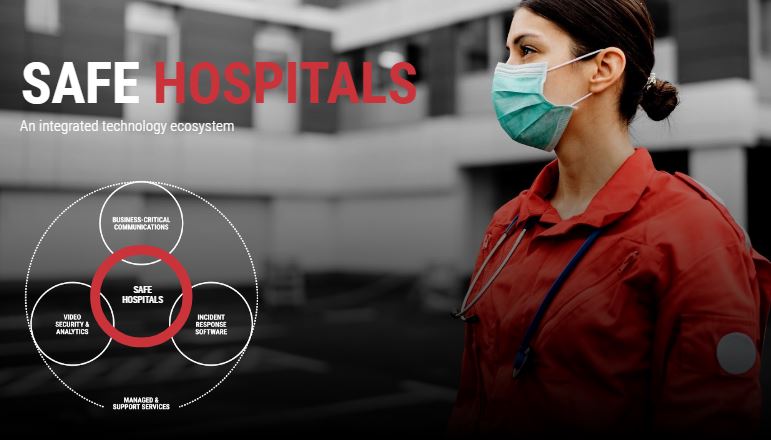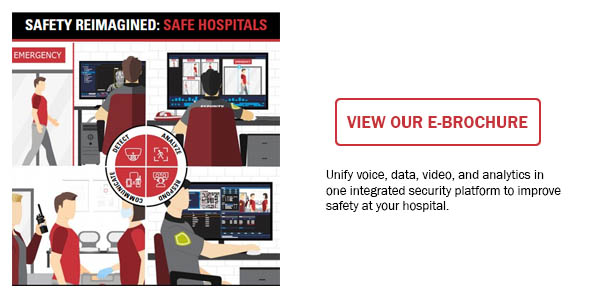Hospital workers and other health care professionals provide life-saving services every day of their careers. The work they do is difficult and challenging, and they deserve the benefit of a secure workplace environment backed by sophisticated safety technology.
There are many risks to health care worker safety in modern medical facilities, several of which can also impact the well-being of patients.
Safety Risks in Modern Hospitals
Among the challenges that exist in modern health care settings, patient elopement, viral infection and violent incidents are particularly significant. There are other potential issues as well, but these challenges are, unfortunately, relatively common. Streamlined security workflows, which are made possible through high-tech support, can help address these interrelated risks.
The Issue of Patient Elopement
Patient elopement is a dangerous phenomenon that can occur when individuals wander away from medical facilities or otherwise exit the establishment without proper support in place or an official discharge.
In early 2020, The News Tribune, a newspaper from Tacoma, Washington, reported that a local psychiatric hospital had been found by authorities to have permitted several serious violations, including multiple elopements. Investigators concluded that the type of doors used in the ambulance bay contributed to the problem.
According to an article from the Mayo Clinic, wandering can take place even in the early stages of Alzheimer’s disease or with other types of dementia.
In a hospital setting, elopement can occur as a result of dementia-related wandering, a desire of involuntarily admitted patients to leave or for other reasons. Regardless of why it takes place, the consequences could be dangerous for the patient and others.
Wandering that occurs within the hospital can also present challenges related to viral transmission or violent incidents.
Viral Transmission Within the Hospital
As we’ve learned throughout the COVID-19 pandemic, in order to ensure safe hospitals, medical facilities must be able to reliably contain the spread of infectious disease. Health care workers need to tend to patients who require treatment for the infection or complications related to it. As they do so, they should not experience an unreasonable risk of exposure.
To make this happen, medical facilities sometimes have to screen visitors while ensuring that patients who are required to quarantine or isolate do not wander. If they do, the hospital must be able to effectively conduct contact tracing.
Violent Altercations
In more ways than one, health care workers have some of the toughest jobs available. The U.S. Bureau of Labor Statistics reported that, in 2018, the most recent year for which data was available, 73% of all violence-related nonfatal injuries or illnesses to occur in the workplace befell health care workers.
In particular, safe hospitals require secure emergency rooms, since these areas are highly accessible. Patient wandering and other issues can also impact the likelihood of experiencing a violent incident.
Ensuring Safe Hospitals By Using Technology to Streamline Workflows
Many of the hospital-related safety risks we’ve outlined can be mitigated by instituting streamlined workflows using technology like the options available through the Safe Hospitals suite from Motorola Solutions and Day Wireless.
The Technology Required for Safe Hospitals
High-tech solutions that help address these issues include Avigilon cameras with analytic software as well as seamless push-to-talk (PTT) communication channels such as Motorola MOTOTRBO two-way radios and incident management software. With cameras that are equipped to monitor for elevated skin temperature and Avigilon Appearance Search technology, it can be easier to locate potential issues and to track the movements of individuals throughout a medical facility. Video analytics services can also monitor for unusual motion, making it possible to quickly spot a potentially aggressive situation before it escalates.
Safe Hospitals in Action
Here’s how an integrated approach to security technology might play out in a typical health care scenario.
Security personnel are notified of an unusual motion event that is captured via surveillance camera. The hospital has over 100 cameras, so the unusual event detection enables the dispatcher to focus his attention on the event. The Avigilon Control Center software zeroes in on the camera.
Security guards receive a text message notification of the event automatically on their two-way radios and stand by for further instructions.
The security dispatcher at the control center is able to analyze the video footage using Appearance Search technology and automatically searches all cameras that have seen where this person has been. The dispatcher then identifies this individual as a patient at risk of elopement.
Security is dispatched via two-way radio to intercept the patient. The security dispatcher is able to monitor the cameras to provide an accurate physical description and share real-time updates on where the patient is headed. A security guard is close by and communicates back to dispatch that they are in pursuit. The situation is quickly resolved and de-escalated.
Then, the incident is logged in the Ally Incident Response software, which provides hospital managers and directors visibility into all incidents so they can potentially identify trends. This way, staff can implement procedural or technological changes to improve safety at the facility.
Follow the Formula: Detect, Analyze, Communicate and Respond
Instead of leveraging disparate technologies, investing in an integrated system like Safe Hospitals ensures that you’ll have a streamlined workflow for handling potential safety concerns at your facility. Siloed processes that are managed independently of each other may limit your ability to respond early enough to change the outcome and prevent elopement or another incident from occurring.
Make Your Hospital Safer Today
Assessing your current technology configuration and determining how to transition to a safety-first solution like Safe Hospitals requires dedicated support and high-level expertise. With an extensive knowledge of Motorola Solutions products and services, the team at Day Wireless Systems is ready to help you mitigate these risks — and others — at your health care facility. Contact us today to learn more.

